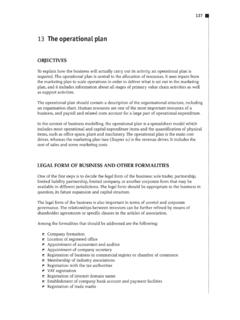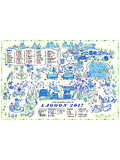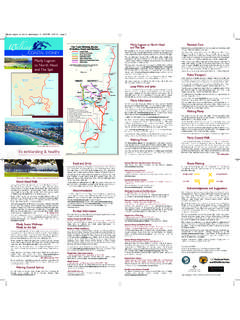Transcription of Strategic Processes @ Nike—Making and Doing Knowledge ...
1 &Research ArticleStrategic Processes @ Nike making andDoing Knowledge ManagementGeorge Stonehouse1*,yand Sonal Minocha2z1 Napier University Business School, Edinburgh, Scotland, UK2 Raffles University, Raffles Education Corporation, SingaporeThis paper contrasts theory with practice through a case study of Strategic Processes ofknowledge management (KM) at Nike Incorporated. From its origins as a small specialistenterprise in 1972 to a multi-billion dollar global brand, the corporation has been continuously atthe forefront of developments in management practice and business innovation.
2 This case studyhas been compiled from interviews with senior managers and numerous secondary sources. Thepaper begins with a discussion of an insider perspective on the trajectory of the organization interms of its Strategic goals and decisions on markets, customers, products, services and businessprocesses. It then goes on to explore and critique the dynamic interplay of the Processes ofstrategizing, learning, creativity and innovation at Nike as the basis for its Knowledge -basedcompetitive advantage (CA).The case thus represents KM as a unique combination of Processes in which learning; strategyand creativity are organized and strategically embedded within a large global organization.
3 Thishas implications for future theorizing in KM, which, as we illustrate in this paper, demands amore integrative approach to research and practice. One of the key lessons for practice is thatspan of activity, as well as strategy, will influence the relationship between strategizing,organizing and learning and this interplay determines the success (or failure) of KM. Copyright#2008 John Wiley & Sons, (1991) argues that Knowledge is the onlysource of lasting competitive advantage (CA) inthe 21st century. This paper illustrates how knowl-edge management (KM) and related Processes areemployed in Nike Incorporated, the global marketleader in the sports apparel industry (Stonehouseet al.)
4 , 2003) as the basis of its competitive begin with a discussion of Nike s CAs, whichare based on its customers and customer knowl-edge, design and development, supply chainmanagement. We conclude that this configurationof Strategic Knowledge Processes does not fullyaccount for Nike s competitive edge as thesesources of superior performance could easilybecome imitable and thus unsustainable if notsupported by the unique ways in which Nikeintegrates the Processes of learning, creativity andinnovation which are, as yet, unparalleled by itscompetition.
5 Kiraka and Manning (2005: 288)have argued that Processes drive or are driven bythe strategy of the organization, yet there is verylittle empirical work on globally successfullyorganizations to support this proposal. This casestudy thus presents a conceptualization of KM as anKnowledge and Process ManagementVolume 15 Number 1 pp 24 31 (2008)Published online 12 February 2008 in Wiley InterScience( ) DOI: *Correspondence to: Professor George Stonehouse, CraiglockhartCampus, Edinburgh EH14 1DJ, Scotland, : and Associate #2008 John Wiley & Sons, phenomenon in which learning andcreativity and strategy Processes interact dynami-cally.
6 This has implications for organizationalpractice and future theorizing in the S COMPETITIVE ADVANTAGESNike is widely recognized as the market leader inthe sports apparel industry by virtue of its marketshare, profitability and global reach (Stonehouseet al., 2003). The company was launched in 1972 andNike s name (that of the Greek goddess of victory)and the swoosh have come to symbolize its successas the leading performer in the industry. Byexamining the Knowledge that underpins Nike sexceptionalperformance,andtheprocessest hrough which it has been created, it is possibleto shed significant light upon the nature of strategicknowledge and its creation and the birth of Nike in 1972, from its humbleorigins in the 1960s as Blue Ribbon Sports (BRS), thecompany has become the global leader of the sportsapparel industry.
7 In 1969, BRS employed 20 peopleand revenues from its several retail outletsamounted to the princely sum of $300 000. By1972, the year of the launch of the Nike brand name,it had more than doubled in size to 45 employeeswith revenues having increased substantially toalmost $2 million. By 1979 revenues were up to $149million, its shoes were being sold in severalcountries including Canada, Asia and Australia,and its products were being manufactured in theUSA, Taiwan and Korea. Nike had almost becomeglobal. In 1981, Nike International was set up to lookafter the company s increasing international oper-ations, which now encompassed more than40 countries.
8 In the same year Nike-England becamethe company s first wholly owned foreign distri-butor. As a direct consequence of this globalexpansion by 1990 Nike s revenues had reached$2 235 244 000 and it was directly employing some5300 people. The global expansion of the companyhas continued at an unprecedented rate so that in2006 its revenues stood at $ billion dollars witha gross profit of $ billion, employing 29 000people worldwide, and a further 650 000 workers incontracted factories around the world. Nike hasgone on to win numerous awards for its designincluding the Industrial Design Excellence award in2005 and the company has also gone on to overturnmuch of its negative press in the 1990s to berecognized as one of the world s most ethicalcompanies in 2007 by Ethisphere s sustained global market leadership in thesports apparel industry is based upon its excep-tional Knowledge of: its customers and theirmotivations; marketing, design and developmentof new products; and management of its supplychain.
9 These Knowledge domains are meldedtogether into the unique Strategic Knowledge , whichconstitutes Nike s core competences and CA. Thissection of the paper details and explains theknowledge base upon which Nike s core compe-tences draw. The subsequent section presents adetailed theoretical and critical analysis of theknowledge base and the ways in which it has beencreated and deployed so as to gain and sustain asignificant competitive and customer knowledgeIn 1972, when Phil Knight and Bill Bowermanformed the company, its products were targeted atthe narrow market sector of serious, competitiveathletes.
10 Of course, most serious athletes are youngmen and women, so that Nike s main customerswere in their late teens and early 20s. The targetingof this customer group of serious athletes led Niketo focus on the development of high performancerunning shoes. Having been keen amateur athletesthemselves, Knight and Bowerman had consider-able tacit and explicit Knowledge of the perform-ance that athletes demand from their shoes. In fact,it was their personal dissatisfaction with existingathletic shoes, which led them to set up Nike toproduce shoes, which were fit for purpose interms of comfort and durability.












